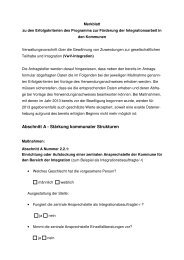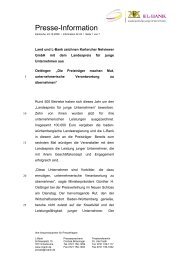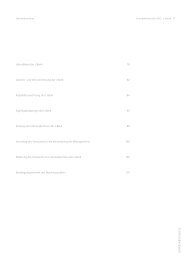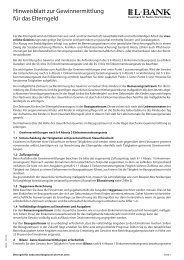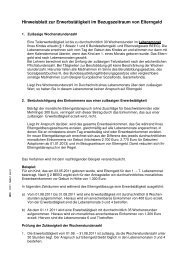Landeskreditbank Baden-Württemberg - L-Bank
Landeskreditbank Baden-Württemberg - L-Bank
Landeskreditbank Baden-Württemberg - L-Bank
Create successful ePaper yourself
Turn your PDF publications into a flip-book with our unique Google optimized e-Paper software.
MANAGEMENT INFORMATION<br />
Introduction<br />
The following Management information is based on our audited unconsolidated annual financial statements<br />
as of and for the fiscal years ended December 31, 2004, 2003 and 2002.<br />
Our financial statements as of and for the fiscal years ended December 31, 2004, 2003 and 2002 were<br />
prepared using German GAAP, as contained in the German Commercial Code (Handelsgesetzbuch), in particular<br />
in the Supplemental Regulations for <strong>Bank</strong>s (Sections 340 et seq. of the German Commercial Code), and in the<br />
German Regulation on the Accounting Principles applied to Credit Institutions and Financial Services<br />
Institutions (Verordnung über die Rechnungslegung der Kreditinstitute und Finanzdienstleistungsinstitute).<br />
For details regarding the principles governing the preparation of our financial statements, see the notes to<br />
our financial statements included in this prospectus and “—Regulation and Supervision of L-<strong>Bank</strong> in the Federal<br />
Republic of Germany—Financial Statements and Audits.” For a description of certain terms used in our balance<br />
sheet and statement of income, see “Glossary.”<br />
German GAAP differs in certain respects from the generally accepted accounting principles of other<br />
countries, such as the United States. For a discussion of certain differences between German GAAP and U.S.<br />
GAAP, see “—Summary of Certain Differences between Generally Accepted German and United States<br />
Accounting Principles.”<br />
Balance Sheet<br />
Our total assets increased by EUR 1.5 billion, or 3.1%, in 2004 to EUR 47.7 billion at December 31, 2004,<br />
as compared to EUR 46.2 billion at December 31, 2003. In addition to liquidity and risk management activities,<br />
loans to small and medium sized enterprises have been the major contributor to this growth. Loans to credit<br />
institutions (assets item 2, “receivables from credit institutions”) increased by 10.2% in 2004 to EUR 13.0 billion<br />
and represented 27.2% of total assets at December 31, 2004 (compared to 25.4% at December 31, 2003). Loans<br />
to customers other than credit institutions (assets item 3, “receivables from customers”) decreased by 1.7% in<br />
2004 to EUR 24.2 billion and represented 50.7% of total assets at December 31, 2004 (compared to 53.2 % at<br />
December 31, 2003).<br />
Borrowings from credit institutions (liabilities item 1, “liabilities to credit institutions”) decreased by 3.2%<br />
over the previous year and amounted to an aggregate of EUR 18.3 billion at December 31, 2004. Borrowings<br />
from customers (liabilities item 2, “liabilities to customers”) decreased by 6.4% and amounted to an aggregate of<br />
EUR 4.8 billion at December 31, 2004. On the other hand, at December 31, 2004, the outstanding amount of<br />
bonds and notes (certificated liabilities) had increased by 10.3% to EUR 18.1 billion from EUR 16.4 billion at<br />
December 31, 2003, which in turn was a 12.6% increase over EUR 14.6 billion in 2002. The Debt Issuance<br />
Program, which was established in 2001, permitted us to attract an increased funding volume via certificated<br />
liabilities. See “—Business—Sources of Funds.”<br />
24



